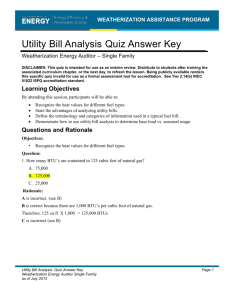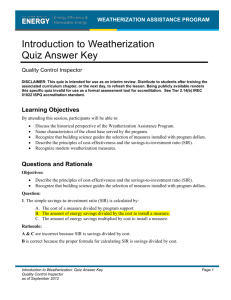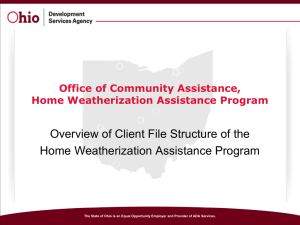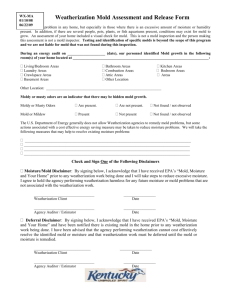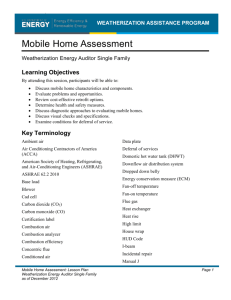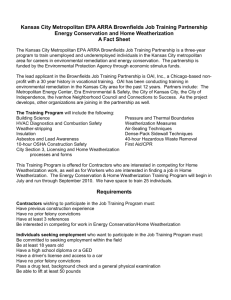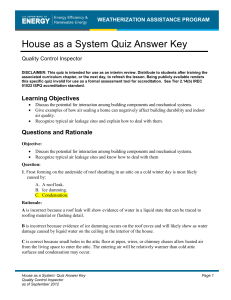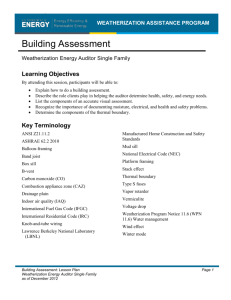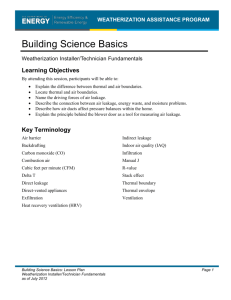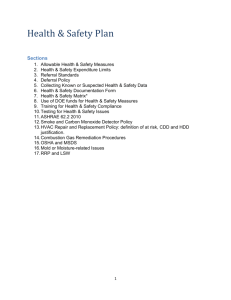Weatherization Energy Auditor – Single Family
advertisement
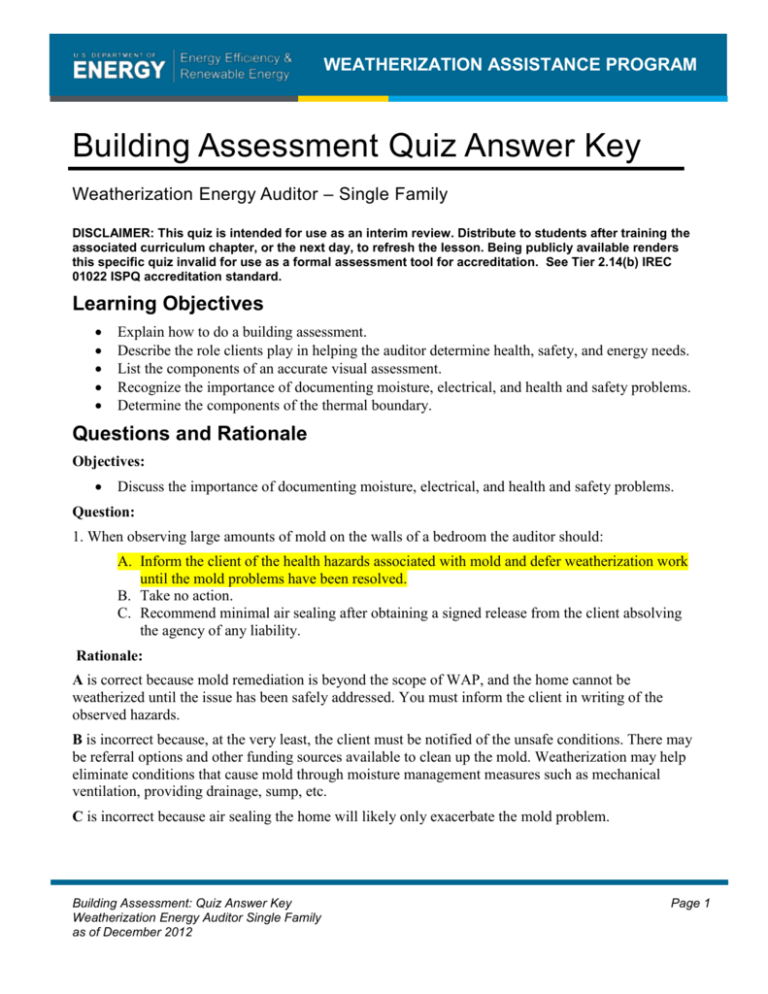
WEATHERIZATION ASSISTANCE PROGRAM Building Assessment Quiz Answer Key Weatherization Energy Auditor – Single Family DISCLAIMER: This quiz is intended for use as an interim review. Distribute to students after training the associated curriculum chapter, or the next day, to refresh the lesson. Being publicly available renders this specific quiz invalid for use as a formal assessment tool for accreditation. See Tier 2.14(b) IREC 01022 ISPQ accreditation standard. Learning Objectives Explain how to do a building assessment. Describe the role clients play in helping the auditor determine health, safety, and energy needs. List the components of an accurate visual assessment. Recognize the importance of documenting moisture, electrical, and health and safety problems. Determine the components of the thermal boundary. Questions and Rationale Objectives: Discuss the importance of documenting moisture, electrical, and health and safety problems. Question: 1. When observing large amounts of mold on the walls of a bedroom the auditor should: A. Inform the client of the health hazards associated with mold and defer weatherization work until the mold problems have been resolved. B. Take no action. C. Recommend minimal air sealing after obtaining a signed release from the client absolving the agency of any liability. Rationale: A is correct because mold remediation is beyond the scope of WAP, and the home cannot be weatherized until the issue has been safely addressed. You must inform the client in writing of the observed hazards. B is incorrect because, at the very least, the client must be notified of the unsafe conditions. There may be referral options and other funding sources available to clean up the mold. Weatherization may help eliminate conditions that cause mold through moisture management measures such as mechanical ventilation, providing drainage, sump, etc. C is incorrect because air sealing the home will likely only exacerbate the mold problem. Building Assessment: Quiz Answer Key Weatherization Energy Auditor Single Family as of December 2012 Page 1 WEATHERIZATION ASSISTANCE PROGRAM Objective: List the components of an accurate visual assessment. Question: 2. List at least 10 components of an accurate visual assessment. Answers can include any of the following: Exterior walk around Note the presence of lead-based paint. Slope of land Note the presence of unvented fossil fuel heaters. Building type and framing Foundation type and percent above grade Cardinal direction and orientation Note the presence and operational condition of mechanical ventilation. Dimensions Check for presence, thickness, condition and type of wall insulation. Siding type and condition Note the thermostat type and setting. Additions, porches, attached or tuck-under garages, cantilevers Determine if the fireplace has an operating damper or glass door. Numbers, types, condition, and orientation of windows and doors Note the number and location of air registers. Roof type, covering, and condition Check for leaks around the window AC unit and whether a cover is available. Chimneys exhaust vents, and possible safety problems Note recessed light fixtures. Water management system issues (downspouts, flashing, grade, etc.) Determination of conditioned vs. unconditioned space Locate and identify building components of the pressure and thermal boundary based on how the client uses the interior spaces. Identify large air leaks such as broken glass, missing hatchway covers, large penetrations, broken ceilings, and damaged wall coverings. Determine framing type (balloon, platform, plank, etc.). Inspect interior wall cladding for damage or weakness. Look for areas where insulation may spill (pocket doors, suspended ceilings, cabinets, closet spaces, etc.). Conditioned or unconditioned basement or crawl space? Combustion appliances and hot water tank Note electrical or other hazards to occupants and weatherization workers. Moisture problems, bulk water intrusion, and other IAQ issues Note evidence and sources of moisture or indoor air quality (IAQ) problems. Major air bypasses and direct penetrations to the outside Ceiling, wall, and band joist insulation levels Page 2 Building Assessment: Quiz Answer Key Weatherization Energy Auditor Single Family as of December 2012 WEATHERIZATION ASSISTANCE PROGRAM Tuck-under garages, coal bins, etc. Condition and insulation levels of duct system Evidence of condensation-based moisture problems or roof leaks Dryer venting Attic ventilation Electrical or other hazards to occupants and weatherization workers Ventilation of mechanical and plumbing terminations and whether they are vented to the outside Note whether band joist and mudsill are sealed or insulated. Note the hot water tank thermostat set point. Knob and tube wiring and other electrical hazards Note insulation on tank and piping. Other hazards such as vermiculite, vermin droppings, etc. Inspect furnace. Open wire splices Inspect foundation walls Uncovered junction boxes Existing insulation levels Frayed wire, etc. Major air bypasses Objective: Determine the components of the thermal boundary. Question: 3. Typical components of the thermal boundary include: A. Attic hatch, ceiling tile, and insulation. B. Ground vapor retarders, roof shingles, and siding. C. Basement slab, soffit vents, and exterior walls of an unheated porch. Rationale: A is correct because the thermal boundary includes air barriers and insulation adjacent to the conditioned space. An effective thermal boundary is where the air barrier and insulation are in alignment. B is incorrect because these building components are not adjacent to the conditioned space. C is incorrect because these building components are not adjacent to the conditioned space. Building Assessment: Lesson Plan Weatherization Energy Auditor Single Family as of December 2012 Page 3 WEATHERIZATION ASSISTANCE PROGRAM Objective: List the components of an accurate visual assessment. Question: 4. Key elements of doing an assessment of the exterior of the home are: (Circle all that apply.) A. B. C. D. Documenting the dimensions of footprint and elevations of the home. Assessing existing wall insulation levels. Differentiating between heated and unheated areas of the home. Documenting building characteristics such as roof and siding types, chimney, and ground slope. E. Noting symptoms of moisture problems. F. Noting existing insulation in the basement. Rationale: A, C, D, & E are correct. B is incorrect because it’s better to assess from inside with IR imaging and probing wall cavities through small, drilled access holes. F is incorrect because this activity requires going into the interior of the home. Objective: Explain how to do a building assessment. Question: 5. Which of the following best describes the steps that are commonly part of a building assessment? A. Review of prior home repairs, check of plumbing fixtures, heating and cooling assessment. B. Client interview, explanation of the audit process, exterior and interior visual assessment and diagnostic testing C. Health and safety assessment, interior visual assessment, operational check of curtains and shades. Rationale: A is incorrect. Though these may all be done as part of an energy audit, reviewing previous home repairs is not a common step in the process, and many common steps are left off the list. B is correct because these are the steps outlined in the presentation as typical of a thorough energy audit. C is incorrect because it does not include all of the common steps, and while auditors may have reasons for checking curtains and shades sometimes, this is not typically part of the energy audit. Page 4 Building Assessment: Quiz Answer Key Weatherization Energy Auditor Single Family as of December 2012 WEATHERIZATION ASSISTANCE PROGRAM Objective: Describe the role clients play in helping the auditor determine health, safety, and energy needs. Question: 6. Clients can provide important health, safety, and energy information to the auditor concerning: A. Number of people living in the home, typical thermostat settings, chronic headaches. B. Exercise schedules, housekeeping practices, control of solar gain. C. Use of fireplaces, employment history of family members, special dietary needs. Rationale: A is correct because all of this information will affect the energy and/or health and safety of the home. The number of people affects ventilation requirements, thermostat settings inform the energy auditor, and chronic headaches may indicate high levels of CO. B is incorrect because exercise schedules are not normally relevant to the energy, health, or safety of the home. C is incorrect because employment and diet aren’t generally useful in determining energy, health, and safety needs of the home. Objective: Recognize the importance of documenting moisture, electrical, and health and safety problems. Question: 7. During the audit you discover uncovered junction boxes in the attic. Your best course of action is to: A. Document this in the audit file, if work is done in the attic this may need to be addressed. B. If already covered with insulation, disregard as it has been proven safe. C. Defer the unit, explaining to the client the unsafe wiring condition you discovered. Rationale: A is correct because auditors should thoroughly document all moisture, electrical, and other health and safety issues discovered during the audit. B is incorrect because auditors should thoroughly document all moisture, electrical, and other health and safety issues discovered during the audit. C is incorrect because this is not generally cause for deferral. The junction boxes can be covered either with health and safety funds or as incidental repair, depending on the state plan and work being done to the home. Building Assessment: Lesson Plan Weatherization Energy Auditor Single Family as of December 2012 Page 5
